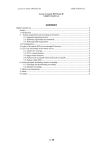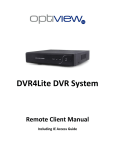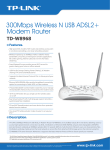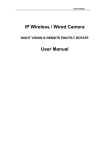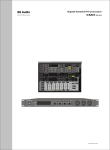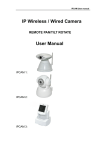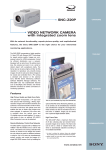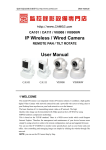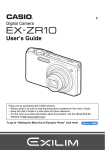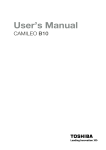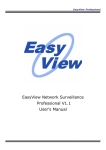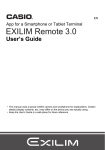Download Access to remote DVR from IE_User`s Manual
Transcript
Access to remote DVR from IE USER’S MANUAL Access to remote DVR from IE USER’S MANUAL CONTENT USER’S MANUAL ..........................................................................................................................2 Preface ......................................................................................................................................2 1. Introduction...........................................................................................................................2 2. System requirement and executing environment ...............................................................2 2.1. Supported operating System: .....................................................................................2 2.2. Hardware requirement (recommend): ........................................................................2 2.3. Web bandwidth requirement: .....................................................................................2 3. IE configuration ....................................................................................................................2 4. Login to the remote DVR server through IE browser...........................................................3 5. Live view and control of the remote server ..........................................................................4 5.1. remote live viewing....................................................................................................4 5.2. P.T.Z. control function................................................................................................5 5.3 image control function ................................................................................................5 5.4. Remote client OSD ....................................................................................................5 6. Search, playback and backup remote recordings ..................................................................6 7. Logs viewing an exporting from the remote server ..............................................................7 8. Status indicator of remote server ..........................................................................................7 9. Remote server configuration.................................................................................................8 1/8 Access to remote DVR from IE USER’S MANUAL Access to remote DVR from IE USER’S MANUAL Preface You can access to remote DVR with remote surveillance without a client software installed. Our DVR supports IE control. The main function of IE control is to view the remote live, playback and backup remote recordings, view and export remote server’s logs, etc. This manual will help you to familiarize with the IE controller and master its operation methods. Notice: A. As product update, the contents of this manual are subject to change without notice. B. Some part functions and symbols may not be completely same with what you get due to the continuous revision of this software. 1. Introduction To use IE controller you have to use IE connect to DVR to download and install the ActiceX controls for remote controlling the DVR. The IE controller designed for embedded digital video recorder to realize remote surveillance management. In the video surveillance system, the administrator can control PTZ, etc through configuring parameters, viewing the live site to achieve the purpose of live site surveillance, video record and record file backup and so on. It possesses three main functions: preview the live site, system configuration and video search. DVR supports multi-users logging in and operating the network client synchronously. 2. System requirement and executing environment 2.1. Supported operating System: Windows 2000/2003/XP ( Need Microsoft .NET Framework 2.0 or later version installed); Windows vista; 2.2. Hardware requirement (recommend): CPU: Intel Core 2 Duo 2.4 or above. Memory: 2GB or above. Graphics card: independent 128M graphics card or above. Network card: 10/100/1000M. 2.3. Web bandwidth requirement: To obtain smoother A/V playing effect, the minimum web bandwidth requirement is: Main stream connection needs 333 Kbps/channel; Secondary stream connection needs 44 Kbps/channel. 3. IE configuration You have to configure the safety certificate of your IE browser before connect to the remote DVR. 2/8 Access to remote DVR from IE USER’S MANUAL Operation steps: (1) Double-click the IE browser icon to open the IE browser. (2) Select “tools > Internet Options” in the menu bar to pop up “internet options” window. (3) Click “security” tab, then click “custom level…” in “security level for this zone” to open “security settings” window. (4) Enable the options which relate with ActiveX controls under the “security settings” window. (5) Click “ok” button. Figure 3 4. Login to the remote DVR server through IE browser (1) Input IP/domain of the DVR in IE textbox, then press “enter” button. (2) Install ActiveX controls automatically. (3) After the ActiveX controls installed the login window will be display in the IE browser. (4) Input the user name, password and control port then click on the “OK” button to access to remote DVR. 3/8 Access to remote DVR from IE USER’S MANUAL Figure 4 5. Live view and control of the remote server Figure 5 5.1. remote live viewing (1) View - Remote view tab. (2) Camera list – camera list of the remote server. 4/8 Access to remote DVR from IE USER’S MANUAL (3) Screen – live view screen. (4) Screen layout - Switch from 1, 4, 9, 16, 36, 64, etc channel views. Simply click on your selected layout to change the layout. (5) Live start/stop – start/stop live view of the remote camera. (6) Screen capture - To capture an image of the display screen, the image will be saved in the path of local folder. (7) Live video recording - To manually start recording live stream, the recording video will be saved in the path of video local folder. (8) Talk – to activate/deactivate tow way real-time talk communication with the connected remote DVR. 5.2. P.T.Z. control function (9) Pan/Tilt buttons – Pans/Tilts camera (10) Auto Pan – Executes a pre-programmed sequence of PTZ commands (11) Assistant1 – assistant function for the PTZ control. (12) Pan/Tilt Speed – Adjusts pan/tilt speed. (13) Assistant2 – another assistant function for the PTZ control. (14) Preset – set current position to preset (15) Preset ID selector – select a preset ID (16) Get preset – get preset position (17) Focus Control – Adjusts focus (18) Zoom Control – Zooms In/Zooms Out (19) Iris Control – Adjusts amount of light entering the camera Note: some DVR model without P.T.Z. control panel. 5.3. 5.3 image control function (20) ~ (23) Via Image Control, you can change brightness, saturation, hue, and sharpness settings of the cameras currently displayed. Simply click on + or – to increase or decrease the selected image control option on the cameras currently displayed. (24) Click the Default button to return settings to the factory default settings for all cameras. Tips: right-click on the live screen to access shortcut operations as shown as following figure. Figure 5.3 5.4. Remote client OSD (25) Time – displays the current date and time of the DVR Server the Remote Client is connected to. (26) Channel name– Indicates camera label/channel name. To modify, please go to remote 5/8 Access to remote DVR from IE USER’S MANUAL configuration. 6. Search, playback and backup remote recordings Figure 6 (1) Playback tab – switch to remote search, playback and backup tab. (2) Camera list – camera list of the remote server. (3) Playback screen – display the remote server recordings. (4) Playback processing bar – indicates the percentage of the playing back recording of the remote server. Click on the slide button to move the playback processing. (5) Play/pause - start/pause playback remote recording. (6) Stop - stop playback. (7) SF – slow forward, decrease the playback speed. Support video playback in 32,8,4,2, normal,1/2,1/4 and 1/8 speed switch in turn. (8) FF - slow forward, increase the playback speed. Support video playback in 1/8, 1/4, 1/2, normal, 2, 4, 8 and 32 speed up switch in turn. (9) Next Frame – Moves playback to the next frame and then pauses the playback. (10) Screen capture - To capture an image of the display screen and save in local folder. (11) Record – recording the playing back screen in local folder. (12) Event type filter – filter the search results by event type. (13) Time filter – filter the search results by time. (14) Card ID filter - filter the search results by ATM card number. (15) Search – to start search the recordings in remote server. (16) Results list – list the search results. (17) Local storage path – display the local storage path where the backup recordings saved. (18) Local storage path setup – change the local storage path where the backup recordings saved. (19) Backup – backup the selected item(s) under the results list to the local folder. (20) Time - displays the recording date and time. 6/8 Access to remote DVR from IE USER’S MANUAL 7. Logs viewing an exporting from the remote server Figure 7 (1) log – switch to remote logs management tab. (2) logs list – list the results logs from the remote server. (3) logs type filter - filter the search results by logs type. (4) time filter - filter the search results by logs time. (5) Search – to start search the logs in remote server. (6) export – export the logs as excel files (.xls) to the local folder. 8. Status indicator of remote server Figure 8 7/8 Access to remote DVR from IE USER’S MANUAL (1) DVR state - switch to remote server status indicator tab. (2) Status indicator – display the status of the remote server. Remote DVR status indicator: Alert – indicates remote DVR alert active/inactive Mute – indicates the mute on/off Schedule – indicates remote DVR schedule active/inactive. VGA – indicates remote DVR VGA output enable/disable. Buzzer – indicates remote DVR buzzer on/off. Update – indicates the remote server updating. Panel Lock – indicates remote DVR panel lock enable/disable. Cruise – indicates remote DVR P.T.Z automatic cruise on/off. Prerecord Buffer – indicates remote DVR enable/disable prerecording buffer. Menu – indicates remote DVR menu operating. Menu saving – indicates the remote server saving the menu changing. 9. Remote server configuration Figure 9 (1) Remote configuration - open the remote server configuration window. (2) Remote DVR configuration – remote server configuration widow. To configure the remote server under remote DVR configuration please refer to the user’s manual of DVR, which is packed in the box with the device. 8/8








